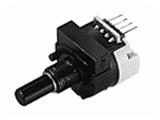
|
optical shaft encoder |
The Elecraft K2/100 comes with an Iwatsu high resolution, metal shaft, dual channel, digital output optical encoder for the main tuning knob frequency control. The encoder that comes standard with the radio is 25 cycles per revolution, which the Elecraft K2/100 firmware quadruples into 100 steps per knob revolution. At the 10 Hz frequency tuning step size, the radio will tune 100 intervals of 10 Hz each, or 1 kHz per knob revolution.
If you want to use the radio all the time in the 10 Hz frequency step setting, then the maximum speed you can go is 1 kHz per revolution of the main tuning knob. This is noticably slower than most HF transceivers today. The Yaesu FT-1000MP, for example, does 10 kHz per revolution of its main tuning knob at a 10 Hz frequency resolution. A 10 kHz/rev tuning speed is much better for phone operation and for contesting. At 1 kHz/rev, a phone contester must spin the tuning knob more than one full revolution just to get to the next signal on a crowded band! To improve the tuning speed of the Elecraft K2/100, one must replace the optical encoder that comes with the radio.
| Possible Replacement Iwatsu Optical Encoders | |||
|---|---|---|---|
| Digikey Part # | Iwatsu Part # | CPR | kHz/rev |
| 102-1001-ND | EC202A050A-2TD | 50 | 2.000 |
| 102-1003-ND | EC202A075A-2TD | 75 | 3.000 |
| 102-1005-ND | EC202A100A-2TD | 100 | 4.000 |
| 102-1007-ND | EC202A128A-2TD | 128 | 5.120 |
| 102-1009-ND | EC202C200A-2TD | 200 | 8.000 |
Fortunately, replacing the optical encoder with a direct replacement of higher resolution is easy. Digikey sells several Iwatsu encoders with more cycles per revolution. For example, an encoder with 200 CPR gets quadrupled by the K2 firmware into 800 steps per revolution or 8 kHz/rev at the 10 Hz step size. The table at right summarizes the different CPR values available and the resulting kHz/rev in the Elecraft K2/100 at the 10 Hz frequency tuning step resolution. I've heard that Digi-Key may now have a minimum order of 50 for these optical encoders. The U.S. distributor of the Iwatsu parts is CUI, Inc. and I have been told that some hams have been able to buy individual parts directly from them.
Replacing the encoder in the Elecraft K2/100 with a new one is pretty simple - you only need to de-solder four connections. I would suggest de-soldering the connections at the Front Panel Board pads rather than on the encoder itself, as the plastic near the solder connections of the encoder tends to melt easily with lots of heat. A better way is to simply replace the stock encoder with the new one when you first build the radio. Someone with significant previous experience with a K2 who knows what the stock encoder tuning rate feels like might prefer this route.
Which encoder should you choose? The 102-1009-ND encoder gives the most cycles per revolution and thus the fastest tuning rate. Unfortunately, at least as of Elecraft K2/100 firmware version 2.02H, the radio cannot keep up with a fast-spinning 8x encoder. The firmware does not sample the optical encoder signals fast enough, so the signals it does see mostly look random. This means that spinning the dial fast will mostly keep the frequency of the radio in the same place, or if you hit just the right speed, will cause it to go in the wrong direction! How fast is too fast? In my personal, subjective opinion, on a scale of 1 to 10 where 1 is really slow and 10 is as fast as I can go, the 8x encoder is OK up to about 5, or a "medium" tuning speed.
Another issue with the 8x encoder is that it will feel more sensitive than a 10 kHz/rev knob twice its size. At 1.5" diameter, the Elecraft K2/100 knob has a circumference of about 9.4". A 3" knob (such as is on the Yaesu FT-1000MP) has a circumference of about 18.8". So, a 3" knob that tunes 10 kHz/rev has a sensitivity of about 531 Hz/inch. The Elecraft K2/100 knob at 8 kHz/rev would have a sensitivity of about 851 Hz/inch. This makes it much harder to settle on an exact 10 Hz frequency step. If the Elecraft K2/100 were modified instead with a 4x encoder, the sensitivity would be about 426 Hz/inch, or much closer to the same feel as a Yaesu FT-1000MP (in this regard.) You will have to make twice as many revolutions to move the same distance up or down the band as you would with a Yaesu FT-1000MP, but your fingers will travel about the same linear distance. This is probably the best solution for such a small knob.
Personally, I have tried both the 8x and 4x encoders, and I am happy with the 4x encoder. If I try really hard, I can still out-spin the ability of the firmware to keep up with the 4x encoder, but it takes effort. Now that I am used to it, I don't think I could go back to a slower tuning rate.